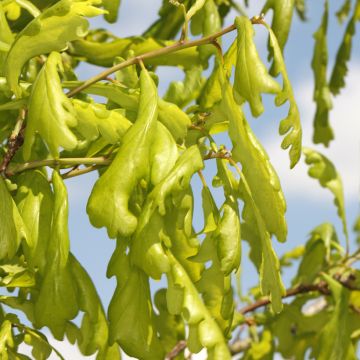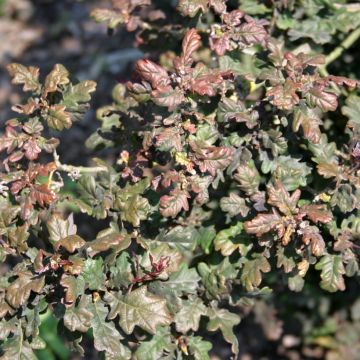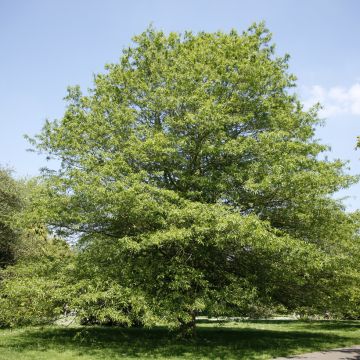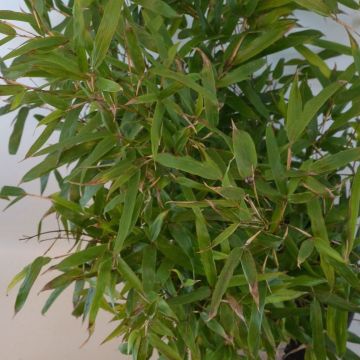

Quercus frainetto - Hungarian Oak


Quercus frainetto - Hungarian Oak


Quercus frainetto - Hungarian Oak


Quercus frainetto - Hungarian Oak


Quercus frainetto - Hungarian Oak


Quercus frainetto - Hungarian Oak


Quercus frainetto - Hungarian Oak
Quercus frainetto - Hungarian Oak
Quercus frainetto
Hungarian Oak
Planted almost a month ago, this oak tree is starting to shed its leaves after autumnal colouration; it looks healthy and promising for the year 2023.
Roger, 14/10/2022
Special offer!
Receive a €20 voucher for any order over €90 (excluding delivery costs, credit notes, and plastic-free options)!
1- Add your favorite plants to your cart.
2- Once you have reached €90, confirm your order (you can even choose the delivery date!).
3- As soon as your order is shipped, you will receive an email containing your voucher code, valid for 3 months (90 days).
Your voucher is unique and can only be used once, for any order with a minimum value of €20, excluding delivery costs.
Can be combined with other current offers, non-divisible and non-refundable.
Why not try an alternative variety in stock?
View all →This plant carries a 24 months recovery warranty
More information
We guarantee the quality of our plants for a full growing cycle, and will replace at our expense any plant that fails to recover under normal climatic and planting conditions.
Would this plant suit my garden?
Set up your Plantfit profile →
Description
Quercus frainetto, the Hungarian oak, is a majestic tree, with fairly rapid growth, hardy and easy to grow in any soil and in a well-cleared location. With a massive crown that spreads with age, and a short trunk, it stands out for the size of its leaves, among the largest in the genus. Intensely lobed, they are green on the upper side, but covered with a whitish down on the underside. Before falling, late in autumn, they take on a beautiful bronze to golden hue. This species will be adopted in a large garden, either as a standalone tree or in alignment.
The Hungarian oak, also known by the Latin names Quercus conferta and Q. pannonica, belongs to the family Fagaceae. It originates from Southeast Europe in an area that extends to the north of Turkey, where it grows at altitudes up to 1000m (3280ft 10in), deeply rooted in often clayey, slightly calcareous and rather dry soils. It is a species that is not very demanding in terms of soil, accepting wet soils and also resistant to wind. Deciduous oaks also have the advantage of producing a good and abundant compost, which is favourable for the growth of plants that germinate under their canopy.
This oak grows rapidly; it will reach an average height of 20m (65ft 7in) and a spread of 12m when mature. Its habit, rather narrow and conical during its youth, becomes more rounded over the years, with the main branches tending to droop on older specimens. Its trunk, quite short, will always be very straight and covered with a finely channelled brownish-grey bark that flakes off in small plates. Upright branches emerge from the trunk, forming a generally spreading and rounded, semi-open crown. Its young twigs are olive green in colour. The characteristic foliage is composed of deciduous leaves that can reach 25cm (9.8in) in length and 14cm (5.5in) in width. Each leaf is divided into numerous rounded lobes, which are themselves dentate along the edges. The colour of the lamina evolves from light and vivid green in spring to glossy green in summer, with the underside covered in a greenish-white down. The flowering of this oak occurs in May, in the form of fairly decorative golden inflorescences. These give way to ovoid acorns, grouped in 2 to 5, which have a characteristic appearance: they are enclosed in a cupule densely covered with short scales. Its root system is deep and powerful, with a taproot type, ensuring a solid and lasting grip in compact or even rocky soils.
Quercus frainetto is a rewarding oak: it will not take fifty years to adopt this respectable stature and majestic appearance that we appreciate so much in these trees. It can be planted either as a standalone tree or in alignment, in a large garden. It also has the advantage of adapting to dry soils, allowing owners of less favourable land to enjoy a very beautiful shade tree, particularly interesting in autumn, but which will let light through in winter. Its fruits, sometimes produced in abundance, feed small animals such as squirrels and jays. It could also be used as a trimmed hedge, like the hornbeam, as it tolerates regular pruning well and its wounds heal remarkably. For example, it can be associated with maples, lindens, and Sophora in a large garden.
Quercus frainetto - Hungarian Oak in pictures


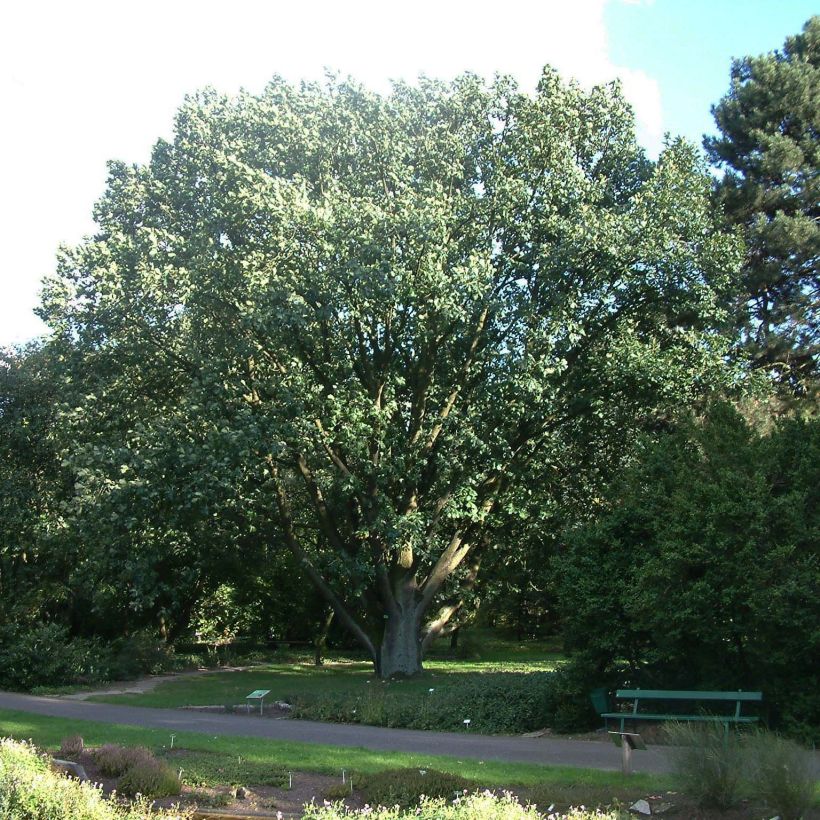

Plant habit
Flowering
Foliage
Botanical data
Quercus
frainetto
Fagaceae
Hungarian Oak
Caucasus
Other Oak
View all →Planting and care
Quercus frainetto grows in ordinary soil, preferably clayey, slightly chalky, neutral or slightly acidic. Once established, this tree with deep anchorage tolerates dry summers well and does not require any watering. It also adapts to much wetter but well-drained soil, where its growth will be faster. It prefers very sunny and well-cleared exposures. Place a sturdy stake to help it start, follow the watering and then let nature take its course. It is a tree that, once installed, requires very little maintenance except for the removal of dead wood. It is not prone to diseases, only powdery mildew is to be feared for its foliage.
Pruning of Quercus frainetto is only useful to occasionally limit its size or to bring some light back to the centre of its silhouette, this pruning work may require the use of dangerous equipment for large specimens. Be careful not to cut too large sections and not to unbalance the tree's habit. This oak can be trained as a hedge if shaped young like a hornbeam.
Planting period
Intended location
Care
Planting & care advice
-
, onOrder confirmed
Reply from on Promesse de fleurs
Similar products
Haven't found what you were looking for?
Hardiness is the lowest winter temperature a plant can endure without suffering serious damage or even dying. However, hardiness is affected by location (a sheltered area, such as a patio), protection (winter cover) and soil type (hardiness is improved by well-drained soil).

Photo Sharing Terms & Conditions
In order to encourage gardeners to interact and share their experiences, Promesse de fleurs offers various media enabling content to be uploaded onto its Site - in particular via the ‘Photo sharing’ module.
The User agrees to refrain from:
- Posting any content that is illegal, prejudicial, insulting, racist, inciteful to hatred, revisionist, contrary to public decency, that infringes on privacy or on the privacy rights of third parties, in particular the publicity rights of persons and goods, intellectual property rights, or the right to privacy.
- Submitting content on behalf of a third party;
- Impersonate the identity of a third party and/or publish any personal information about a third party;
In general, the User undertakes to refrain from any unethical behaviour.
All Content (in particular text, comments, files, images, photos, videos, creative works, etc.), which may be subject to property or intellectual property rights, image or other private rights, shall remain the property of the User, subject to the limited rights granted by the terms of the licence granted by Promesse de fleurs as stated below. Users are at liberty to publish or not to publish such Content on the Site, notably via the ‘Photo Sharing’ facility, and accept that this Content shall be made public and freely accessible, notably on the Internet.
Users further acknowledge, undertake to have ,and guarantee that they hold all necessary rights and permissions to publish such material on the Site, in particular with regard to the legislation in force pertaining to any privacy, property, intellectual property, image, or contractual rights, or rights of any other nature. By publishing such Content on the Site, Users acknowledge accepting full liability as publishers of the Content within the meaning of the law, and grant Promesse de fleurs, free of charge, an inclusive, worldwide licence for the said Content for the entire duration of its publication, including all reproduction, representation, up/downloading, displaying, performing, transmission, and storage rights.
Users also grant permission for their name to be linked to the Content and accept that this link may not always be made available.
By engaging in posting material, Users consent to their Content becoming automatically accessible on the Internet, in particular on other sites and/or blogs and/or web pages of the Promesse de fleurs site, including in particular social pages and the Promesse de fleurs catalogue.
Users may secure the removal of entrusted content free of charge by issuing a simple request via our contact form.
The flowering period indicated on our website applies to countries and regions located in USDA zone 8 (France, the United Kingdom, Ireland, the Netherlands, etc.)
It will vary according to where you live:
- In zones 9 to 10 (Italy, Spain, Greece, etc.), flowering will occur about 2 to 4 weeks earlier.
- In zones 6 to 7 (Germany, Poland, Slovenia, and lower mountainous regions), flowering will be delayed by 2 to 3 weeks.
- In zone 5 (Central Europe, Scandinavia), blooming will be delayed by 3 to 5 weeks.
In temperate climates, pruning of spring-flowering shrubs (forsythia, spireas, etc.) should be done just after flowering.
Pruning of summer-flowering shrubs (Indian Lilac, Perovskia, etc.) can be done in winter or spring.
In cold regions as well as with frost-sensitive plants, avoid pruning too early when severe frosts may still occur.
The planting period indicated on our website applies to countries and regions located in USDA zone 8 (France, United Kingdom, Ireland, Netherlands).
It will vary according to where you live:
- In Mediterranean zones (Marseille, Madrid, Milan, etc.), autumn and winter are the best planting periods.
- In continental zones (Strasbourg, Munich, Vienna, etc.), delay planting by 2 to 3 weeks in spring and bring it forward by 2 to 4 weeks in autumn.
- In mountainous regions (the Alps, Pyrenees, Carpathians, etc.), it is best to plant in late spring (May-June) or late summer (August-September).
The harvesting period indicated on our website applies to countries and regions in USDA zone 8 (France, England, Ireland, the Netherlands).
In colder areas (Scandinavia, Poland, Austria...) fruit and vegetable harvests are likely to be delayed by 3-4 weeks.
In warmer areas (Italy, Spain, Greece, etc.), harvesting will probably take place earlier, depending on weather conditions.
The sowing periods indicated on our website apply to countries and regions within USDA Zone 8 (France, UK, Ireland, Netherlands).
In colder areas (Scandinavia, Poland, Austria...), delay any outdoor sowing by 3-4 weeks, or sow under glass.
In warmer climes (Italy, Spain, Greece, etc.), bring outdoor sowing forward by a few weeks.














































